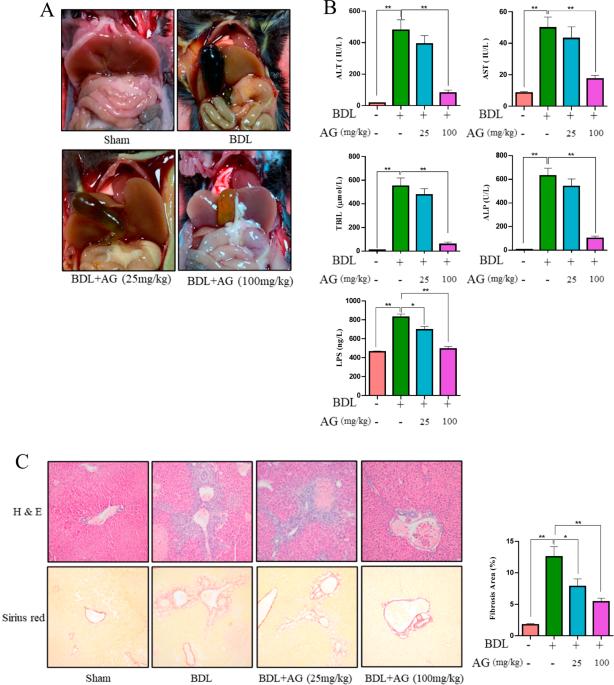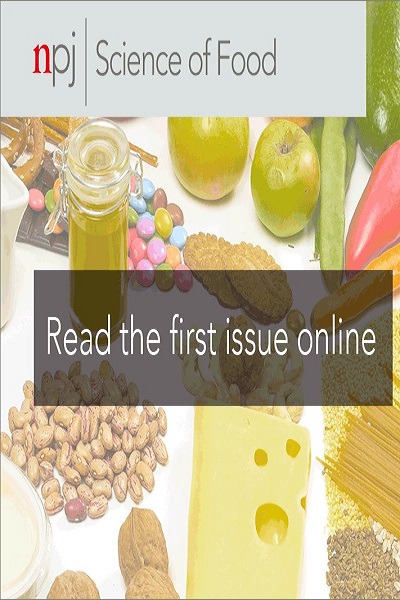Ampelopsis grossedentata tea alleviating liver fibrosis in BDL-induced mice via gut microbiota and metabolite modulation
IF 7.8
1区 农林科学
Q1 FOOD SCIENCE & TECHNOLOGY
引用次数: 0
Abstract
Liver fibrosis (LF) is a common sequela to diverse chronic liver injuries, leading to rising rates of cirrhosis and hepatocellular carcinoma (HCC). As the medicinal and edible homologous material, traditional teas have exhibited promising applications in the clinical management of liver fibrosis. Here, we generated a liver fibrosis mouse model to explore the potent therapeutic ability of Ampelopsis grossedentata (AG) tea on this condition by multi-omics analysis. The biochemistry results pointed towards mitigated increases of ALT, AST, TBIL, and ALP triggered by BDL in the AG-treated group. Examination using H&E and Sirius Red staining revealed severe liver injuries, inflammation infiltration, amplified fibrosed regions, and the creation of bile ducts, all of which were fallout from BDL. Immunohistochemistry findings also implicated a noteworthy upregulation of the HSC activation marker α-smooth muscle actin (α-SMA) and the fibrosis marker collagen I in the BDL group. However, these symptoms demonstrated a significant improvement in the group treated with 100 mg/kg AG. Findings from the Western Blot test corroborated the prominent elevation of TNF-α, col1a1, α-SMA, and TGF-β, instigated by BDL, while AG treatment meaningfully modulated these proteins. Furthermore, our study underscored the potential involvement of several microbiota, such as Ruminococcaceae UCG-014, Eubacterium Ruminantium, Ruminococcus 1, Christensenellaceae R-7, Acetatifactor, Dubosiella, Parasutterella, Faecalibaculum, and Defluviitaleaceae UCG-011, in the progression of liver fibrosis and the therapeutic efficacy of AG. This investigation shows that during the process of AG ameliorating BDL-induced liver fibrosis, bile acid derivatives such as CDCA, TCDCA, 3-DHC, UCA, DCA, among others, play significant roles. In this study, we identified that several non-bile acid metabolites, such as Deltarasin, Thr-Ile-Arg, etc., are entailed in the process of AG improving liver fibrosis.

毛蕊花茶通过调节肠道微生物群和代谢物减轻BDL诱导的小鼠肝纤维化。
肝纤维化(LF)是各种慢性肝损伤的常见后遗症,导致肝硬化和肝细胞癌(HCC)发病率上升。传统茶叶作为药食同源的材料,在肝纤维化的临床治疗中具有广阔的应用前景。在此,我们建立了一个肝纤维化小鼠模型,通过多组学分析来探索毛蕊花茶(AG)对肝纤维化的有效治疗能力。生化结果表明,AG治疗组的BDL引发的ALT、AST、TBIL和ALP升高有所缓解。使用 H&E 和天狼星红染色法进行的检查显示,肝脏损伤严重、炎症浸润、纤维化区域扩大、胆管形成,所有这些都是 BDL 的后果。免疫组化结果还显示,在 BDL 组中,造血干细胞活化标志物α-平滑肌肌动蛋白(α-SMA)和纤维化标志物胶原 I 显著上调。然而,这些症状在接受 100 mg/kg AG 治疗的组别中得到了明显改善。Western Blot 检测结果证实,BDL 会导致 TNF-α、col1a1、α-SMA 和 TGF-β 的显著升高,而 AG 治疗可有效调节这些蛋白。此外,我们的研究还强调了几种微生物群(如反刍球菌科 UCG-014、反刍大肠杆菌、反刍球菌 1、Christensenellaceae R-7、Acetatifactor、Dubosiella、Parasutterella、Faecalibaculum 和 Defluviitaleaceae UCG-011)可能参与了肝纤维化的进展和 AG 的疗效。这项研究表明,在 AG 改善 BDL 诱导的肝纤维化的过程中,胆汁酸衍生物如 CDCA、TCDCA、3-DHC、UCA、DCA 等发挥了重要作用。在本研究中,我们发现了一些非胆汁酸代谢产物,如Deltarasin、Thr-Ile-Arg等,也参与了AG改善肝纤维化的过程。
本文章由计算机程序翻译,如有差异,请以英文原文为准。
求助全文
约1分钟内获得全文
求助全文
来源期刊

NPJ Science of Food
FOOD SCIENCE & TECHNOLOGY-
CiteScore
7.50
自引率
1.60%
发文量
53
期刊介绍:
npj Science of Food is an online-only and open access journal publishes high-quality, high-impact papers related to food safety, security, integrated production, processing and packaging, the changes and interactions of food components, and the influence on health and wellness properties of food. The journal will support fundamental studies that advance the science of food beyond the classic focus on processing, thereby addressing basic inquiries around food from the public and industry. It will also support research that might result in innovation of technologies and products that are public-friendly while promoting the United Nations sustainable development goals.
 求助内容:
求助内容: 应助结果提醒方式:
应助结果提醒方式:


